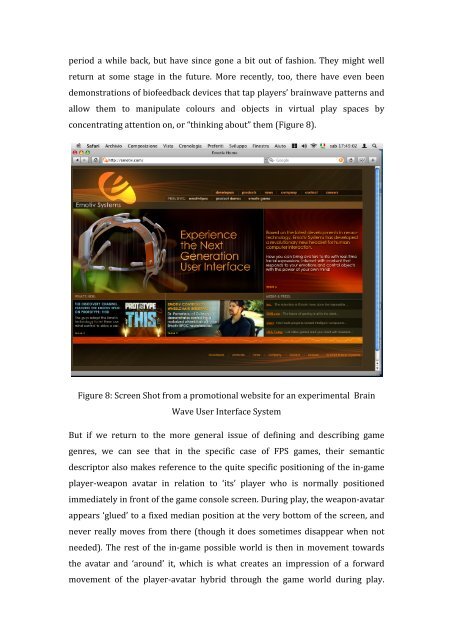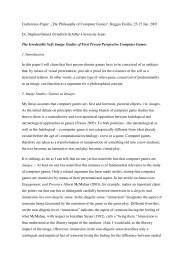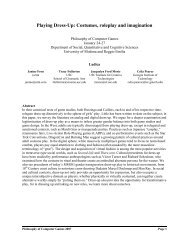+++ INCOMPLETE DRAFT VERSION (PLEASE DO NOT QUOTE) ++ ...
+++ INCOMPLETE DRAFT VERSION (PLEASE DO NOT QUOTE) ++ ...
+++ INCOMPLETE DRAFT VERSION (PLEASE DO NOT QUOTE) ++ ...
You also want an ePaper? Increase the reach of your titles
YUMPU automatically turns print PDFs into web optimized ePapers that Google loves.
period a while back, but have since gone a bit out of fashion. They might wellreturn at some stage in the future. More recently, too, there have even beendemonstrationsofbiofeedbackdevicesthattapplayers’brainwavepatternsandallow them to manipulate colours and objects in virtual play spaces byconcentratingattentionon,or“thinkingabout”them(Figure8).Figure8:ScreenShotfromapromotionalwebsiteforanexperimentalBrainWaveUserInterfaceSystemBut if we return to the more general issue of defining and describing gamegenres, we can see that in the specific case of FPS games, their semanticdescriptoralsomakesreferencetothequitespecificpositioningofthein‐gameplayer‐weapon avatar in relation to ‘its’ player who is normally positionedimmediatelyinfrontofthegameconsolescreen.Duringplay,theweapon‐avatarappears‘glued’toafixedmedianpositionattheverybottomofthescreen,andnever really moves from there (though it does sometimes disappear when notneeded). The rest of the in‐game possible world is then in movement towardsthe avatar and ‘around’ it, which is what creates an impression of a forwardmovement of the player‐avatar hybrid through the game world during play.






